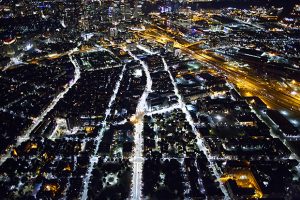LED Street Lighting
With concern for rising global emissions and the majority of the worlds power still generated by burning fuels of one kind of another, the replacement of older street lighting technologies with higher efficiency and longer life LED Street Lighting would appear to make sense. And on the up side, everyone agrees that the longer life of the LEDs compared to other lighting technologies is a huge plus.
However, it turns out to be not as simple as that. In LED Streetlights Are Giving Neighbourhoods the Blues the author, Jeff Hecht, points out a few other issues to consider. The picture below graphically demonstrates one of them.
Colour Temperature, or how warm or cold a light appears to our eyes, has a significant impact on how we perceive the lights. Above we see very white looking LED lighting alongside more traditional High Pressure Sodium lamps. The much bluer LED Street Lights cause several serious issues including:
- actually reducing our ability to see clearly at night
- disturbing noctural creatures more (eg. hatching turtles)
- affecting sleep patterns
- affecting biorythms
- decreasing our ability to see stars at night
So the energy savings are real, but the environmental side affects are too.
Managing Colour Temperature
Unfortunately LEDs are not as easy to control for Colour Temperature. Unlike an incandescent light, they emit a very narrow band of wavelengths of light. And most White LEDs emit blue and use a phosphor to down convert some of the Blue to Yellow so they look whiter rather than Bluer. The earliest White LEDs were very blue and so early adopters of LED Street Lighting have ended up with the worst outcome. And the more we warm up the colour the lower the efficiency because we lose some energy in the down conversion.
The are some breakthrough underway and Cree have recently discovered that it is more efficient to add some red LEDs to the mix to drop the perceived colour temperature. And this is helping. But even the newest devices are at a colour temperature of 3000K and the High Pressure Sodium Lamps are at around 2100K. So still quite a bit different.
The only solution for the millions of already installed LED Street Lighting is unfortunately to swap them out for more recent LED arrays that are at a better colour temperature.
Successful Endeavours specialise in Electronics Design and Embedded Software Development, focusing on products that are intended to be Made In Australia. Ray Keefe has developed market leading electronics products in Australia for more than 30 years. This post is Copyright © 2016 Successful Endeavours Pty Ltd.




